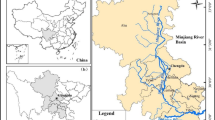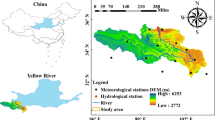Abstract
The contradictory problem between water quality-induced water shortage and shortage of water quantity has been increasingly emerging. This research aims to control the total pollutant discharge in a transboundary river basin, to improve the water environment, and enhance the capabilities of water resources management and decision-making. The organic connection between the control of total discharge quantity, the reduction of pollutant discharge, and the improvement of water environmental quality is established at large-scale from the perspective of comprehensive decision-making and management. In addition, this paper innovatively proposes a comprehensive watershed management model of multi-level and stepwise optimization for allocation of total load of water pollutants, which is integrated through the Gini coefficients method, the comprehensive weights method, and the minimal optimization model of environmental Gini coefficient. It is capable of optimizing distributions of total amount control of water pollutants in the whole basin and controlling units both spatially and temporally. The model is applied to the Songhua River basin to address the conflicts among regions’ environmental fairness and environmental sustainability. According to the optimization results based on the proposed model, the scheme for the total load allocation of water pollutants developed through optimization is consistent with the actual present situation of Heilongjiang section. Major dischargers like Harbin, Suihua, Qiqihar, and Daqing are mainly controlled, and the control units with a low discharge load were rationally controlled. The study has shown that the model was useful in providing decision-making support for water pollution total amount control of the Songhua River basin.






Similar content being viewed by others
References
Afshar A, Masoumi F (2016) Waste load reallocation in river-reservoir systems: simulation-optimization approach. Environ Earth Sci 75(1):1–14
Alnail M, Kabenge M, Li J et al (2013) Pollution control on River Nile in the White Nile State sugar hub of Sudan. Environ Sci Technol 47(22):12628–12629
Boye BA, Falconer RA, Akande K (2015) Integrated water quality modelling: application to the Ribble Basin, U.K. J Hydroenviron Res 9(2):187–199
Cecchi T (2014) Identification of representative pollutants in multiple locations of an Italian school using solid phase micro extraction technique. Build Environ 82:655–665
Chen Y, Lu H, Li J, Huang G, He L (2016) Regional planning of new-energy systems within multi-period and multi-option contexts: A case study of Fengtai, Beijing, China. Renew Sustain Energy Rev 65:356–372
Chen Y, He L, Guan Y, Lu H, Li J (2017) Life cycle assessment of greenhouse gas emissions and water-energy optimization for shale gas supply chain planning based on multi-level approach: Case study in Barnett, Marcellus, Fayetteville, and Haynesville shales. Energy Convers and Manage 134:382–398
Cho JH, Lee JH (2015) Watershed model calibration framework developed using an influence coefficient algorithm and a genetic algorithm and analysis of pollutant discharge characteristics and load reduction in a TMDL planning area. J Environ Manag 163:2–10
Erdlenbruch K, Tidball M, Zaccour G (2014) Quantity–quality management of a groundwater resource by a water agency. Environ Sci Policy 44:201–214
Fan FM, Fleischmann A, Collischonn W et al (2015) Large-scale analytical water quality model coupled with GIS for simulation of point sourced pollutant discharges. Environ Model Softw 64:58–71
Fonseca A, Botelho C, Boaventura RAR et al (2014) Integrated hydrological and water quality model for river management: a case study on Lena River. Sci Total Environ 485–486:474–489
Groves-Kirkby CJ, Denman AR, Phillips PS (2009) Lorenz curve and Gini coefficient: novel tools for analysing seasonal variation of environmental radon gas. J Environ Manag 90:2480–2487
Gunasekara NK, Kazama S, Yamazaki D et al (2014) Water conflict risk due to water resource availability and unequal distribution. Water Resour Manag 28(1):169–184
He L, Chen Y, Zhao H, Tian P, Xue Y, Chen L (2018) Game-based analysis of energy-water nexus for identifying environmental impacts during Shale gas operations under stochastic input. Sci Total Environ 627:1585–1601
Huang S, He SM, Xu H et al (2015) Monitoring of persistent organic pollutants in seawater of the Pearl River Estuary with rapid on-site active SPME sampling technique. Environ Pollut 200:149–158
Lofrano G, Libralato G, Acanfora FG et al (2015) Which lesson can be learnt from a historical contamination analysis of the most polluted river in Europe? Sci Total Environ 524–525:246–259
Marques J, Cunha M, Savić DA (2015) Multi-objective optimization of water distribution systems based on a real options approach. Environ Model Softw 63:1–13
Melkamu M, Bannor RK (2015) Estimation of agricultural resource inequality in India using Lorenz curve and Gini coefficient approach. Int J Curr Res Acad Rev 3(4):174–184
Moskowitz CS, Seshan VE, Riedel ER et al (2008) Estimating the empirical Lorenz curve and Gini coefficient in the presence of error with nested data. Stat Med 27(16):3191–3208
Najar IA, Khan AB (2012) Assessment of water quality and identification of pollution sources of three lakes in Kashmir, India, using multivariate analysis. Environ Earth Sci 66(8):2367–2378
Nikoo MR, Kerachian R, Karimi A et al (2014) Optimal water and waste load allocation in reservoir-river systems: a case study. Environ Earth Sci 71(9):4127–4142
Nnane DE, Ebdon JE, Taylor HD (2011) Integrated analysis of water quality parameters for cost-effective faecal pollution management in river catchments. Water Res 45(6):2235–2246
Omosa IB, Wang H, Cheng S et al (2012) Sustainable tertiary wastewater treatment is required for water resources pollution control in Africa. Environ Sci Technol 46(13):7065–7066
Panagopoulos Y, Makropoulos C, Mimikou M (2011) Diffuse surface water pollution: driving factors for different geoclimatic regions. Water Resour Manag 25(14):3635–3660
Pedro-Monzonís M, Solera A, Ferrer J et al (2015) A review of water scarcity and drought indexes in water resources planning and management. J Hydrol 527:482–493
Privette CV, Taylor SW, Hayes JC et al (2015) Forecasting the impacts of future development on water quantity and quality within the Reedy River watershed. Land Use Policy 44:1–9
Saaty TL (1987) A new macroeconomic forecasting and policy evaluation method using the analytic hierarchy process. Math Model 9(3):219–231
Saha D, Kemanian AR, Montes F et al (2018) Lorenz curve and Gini coefficient reveal hot spots and hot moments for nitrous oxide emissions. J Geophys Res Biogeosci 123:193–206
Shomar B, Darwish M, Rowell C (2014) What does integrated water resources management from local to global perspective mean? Qatar as a case study, the very rich country with no water. Water Resour Manag 28(10):2781–2791
Singh RP, Nachtnebel HP (2016) Analytical hierarchy process (AHP) application for reinforcement of hydropower strategy in Nepal. Renew Sustain Energy Rev 55:43–58
Skardi MJE, Afshar A, Saadatpour M et al (2015) Hybrid ACO-ANN-based multi-objective simulation-optimization model for pollutant load control at basin scale. Environ Model Assess 20(1):29–39
Sun T, Zhang HW, Wang Y et al (2010) The application of environmental Gini coefficient (EGC) in allocating wastewater discharge permit: the case study of watershed total mass control in Tianjin, China. Resour Conserv Recycl 54(9):601–608
Tissier G, Perrette Y, Dzikowski M et al (2013) Seasonal changes of organic matter quality and quantity at the outlet of a forested karst system (La Roche Saint Alban, French Alps). J Hydrol 482:139–148
Tsuzuki Y (2015) Relationships between pollutant discharge and water quality in the rivers from “better” to “worse” water quality. Ecol Ind 52:256–269
Ultsch A, Lötsch J (2017) A data science based standardized Gini index as a Lorenz dominance preserving measure of the inequality of distributions. Plos One 12(8):e0181572
Verde R, Vigliotti M, Prevedello L et al (2013) An integrated approach to environmental quality assessment in a coastal setting in Campania (Southern Italy). Environ Earth Sci 70(1):407–404
Wang C, Bi J, Robert B, Ambrose J (2015) Development and application of mathematical models to support total maximum daily load for the Taihu Lake’s influent rivers, China. Ecol Eng 83:258–267
Yoon T, Rhodes C, Shah FA (2015) Upstream water resource management to address downstream pollution concerns: a policy framework with application to the Nakdong River basin in South Korea. Water Resour Res 51:787–805
Yu S, Lu HW (2018a) Relationship between urbanisation and pollutant emissions in transboundary river basins under the strategy of the Belt and Road Initiative. Chemosphere 203:11–20
Yu S, Lu HW (2018b) An integrated model of water resources optimization allocation based on projection pursuit model—grey wolf optimization method in a transboundary river basin. J Hydrol 559:156–165
Yu S, Wang MY (2014) Comprehensive evaluation of scenario schemes for multi-objective decision-making in river ecological restoration by artificially recharging river. Water Resour Manag 28(15):5555–5571
Yu S, He L, Lu HW (2016) An environmental fairness based optimisation model for the decision-support of joint control over the water quantity and quality of a river basin. J Hydrol 535:366–376
Zhao Y, Sharma A, Sivakumar B et al (2014) A Bayesian method for multi-pollution source water quality model and seasonal water quality management in river segments. Environ Model Softw 57:216–226
Acknowledgements
This research was supported by the Strategic Priority Research Program of Chinese Academy of Sciences (XDA20040300) China Postdoctoral Science Foundation-China (2016M591139), the Fundamental Research Funds for the Central Universities-China (JB2016072), and Major Science and Technology Program for Water Pollution Control and Treatment-(2012ZX07601002).
Author information
Authors and Affiliations
Corresponding authors
Rights and permissions
About this article
Cite this article
Yu, S., Lu, H. Integrated watershed management through multi-level and stepwise optimization for allocation of total load of water pollutants at large scales. Environ Earth Sci 77, 373 (2018). https://doi.org/10.1007/s12665-018-7545-9
Received:
Accepted:
Published:
DOI: https://doi.org/10.1007/s12665-018-7545-9




